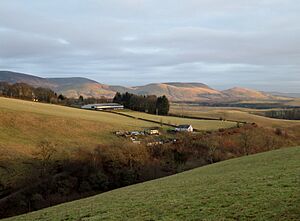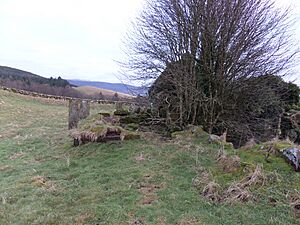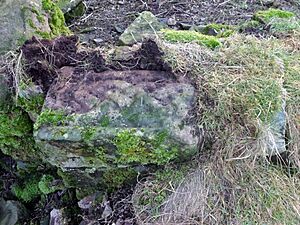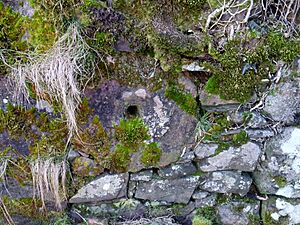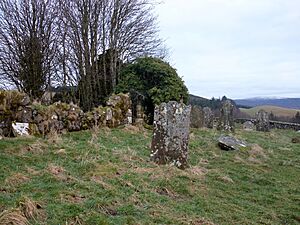Kirkbride, Durisdeer facts for kids
Quick facts for kids Kirkbride, Durisdeer
|
|
|---|---|
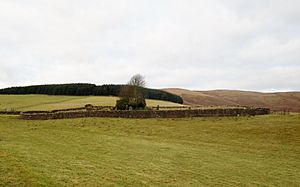 Kirkbride and cemetery |
|
| OS grid reference | NS854056 |
| Council area | |
| Lieutenancy area | |
| Country | Scotland |
| Sovereign state | United Kingdom |
| Post town | Sanquhar |
| Police | Dumfries and Galloway |
| Fire | Dumfries and Galloway |
| Ambulance | Scottish |
| EU Parliament | Scotland |
| UK Parliament |
|
| Scottish Parliament |
|
Kirkbride, also known as Kilbride, was once an old church area or "parish" in Scotland. It was located near the village of Enterkinfoot in Dumfries and Galloway. The land of Kirkbride stretched across both sides of the River Nith. It was about 5 miles south of Sanquhar.
In 1732, the Kirkbride parish was closed down. Its land was then split between the nearby parishes of Durisdeer and Sanquhar. Today, the old church building is a protected historical site. The graveyard around it is also a special listed building. The River Nith flows in the valley below. A small stream called Ha Cleuch Burn runs through the glen to the east. A lane from Enterkinfoot leads up to the site, ending at Coshogle Farm.
Contents
Exploring Kirkbride's Past
The Kirkbride church was named after St Bride. She is also known as Brigit or Bridget. People believe that Saint Mungo founded this church. He also founded St Conal's church at Kirkconnel. In the 1200s, during the time of King Alexander II, the church was given to the monks of Holyrood Abbey.
There is still some discussion about whether St Bride was a real saint. This is because the Celtic goddess Brigid has the same name and special day. In 1240, the Bishop of Glasgow confirmed the church's gift to Holyrood Abbey. Kirkbride then became its own church, with its own minister. It stayed that way until the Reformation.
The Old Kirk and Churchyard
The ruins you see today are from a church built in the early 1500s. It was a rectangular building, facing east to west. It had a small room called a sacristy on its north side. People say it could only hold about 100 churchgoers. This church was one of the first built in Scotland after the Reformation. However, it replaced an even older chapel. Some of the church stones were taken to build the nearby Kirkbride Farm. This farm was also once a mill.
The Kirkbride parish was closed down in 1732. Its land was added to Sanquhar and Durisdeer parishes. Some records say this happened in 1727. Kirkbride was the first parish in southwest Scotland to join the new Protestant faith. At first, the church building was not allowed to be used. So, the church members met in the churchyard. They gathered around an old thorn tree. The Pope even listed this thorn tree in his yearly list of excommunications!
The south side of the church still has a very narrow doorway. It also has two windows. One is near where the altar would have been. The other is at the western end of the main church area. A large stone block inside was once part of the old bell tower. In the wall, near the sacristy, there is a stone with Celtic carvings. This might be part of an old cross.
In 1920, a piece of a tombstone was found in the church. It had the words "Orate Propiciet" carved on it. This means "Pray for the soul" in Latin.
The Church's Unroofing
In the 1740s, a former leader of Sanquhar, Abraham Crichton, had the old church partly unroofed. He thought the church members were mostly Whigs. This meant they supported the Covenanters and the Hanoverian royal family. Abraham Crichton was likely a Tory and a Jacobite. He said he would "soon pull down the Whig's sanctuary."
However, a terrible storm started, and the work stopped. Abraham Crichton died soon after from falling off his horse. The old church members believed this was God's punishment. They saw it as punishment for his role in closing the parish and damaging the church. The church is very similar to the early 1500s church at Little Dalton.
The churchyard is a protected site. It has many gravestones from the 1600s and 1700s. The graveyard is square-shaped and surrounded by stone walls. These walls are quite high in some places because of the sloping ground. The gate to the graveyard is on the east side. In 1807, people were still using the graveyard for burials.
The church bell was stolen after the church was abandoned. It was found in Glasgow because people recognized its sound. It was brought back and hung in the small bell tower. But the tower fell, and no one knows where the bell is now. A special coin, called a Communion Token, from Kirkbride (dated 1725) is kept at the Dumfries Museum.
The Manse (Minister's House)
We don't know exactly where the minister's house, called the manse, stood. It might have been at Kirkbride Farm. People described it as looking like a castle. It had very thick walls to protect against strong winds. It was torn down before 1846. It was so strong that it took a lot of effort to pull it down.
Ministers of Kirkbride
The first minister recorded was Walter de Lillescliff. He served during the time of Edward I. There's a story about a minister before the Reformation. He was chased out of the parish by five church members. He had not been doing his duties well. He escaped through a window and ran away towards Wanlockhead.
Reverend Peter Rae
The last minister of Kirkbride was Reverend Peter Rae. He served from 1703 until the parish closed in 1732. He caused some debate among his church members. This was because he ran a printing press from Kirkbride starting around 1712. Later, he moved his printing business to Dumfries. His business published the 'Dumfries Mercury'. This was Scotland's first newspaper outside of Glasgow and Edinburgh.
Rae also published his own writings. These included a paper against the Acts of Union of 1707. He also wrote "A History of the Late Rebellion (1718)." Both of these are still studied today. He even named his eight-year-old son as the owner of his business. He did this to avoid criticism.
Rae also made an astronomical clock for Drumlanrig Castle. He surveyed Lochar Moss and worked as an agent for the Wanlockhead lead mines. He was born in 1671 and died in 1748. He married Agnes Corsane. People joked about him, saying:
|
"The printing trade he now does try, |
One surprising story about him is that he was once brought before the church leaders. He had attacked a local woman he thought was a witch. He hit her on the forehead and drew blood. People believed this would stop the 'Evil Eye'. Soon after, he became the clerk for the same group of church leaders.
Kirkbride Mill and Old Stones
An 1856 map shows a dam and a mill pond on the Stroquhairn Burn. It had channels and a mill race leading to Kirkbride Farm. The water then flowed into the Ha Cleuch Burn. A very worn grindstone is built into the south wall of the church near the door. This stone might have been used for grinding grain.
Local Place Names and History
| Meaning of Names |
| The name Hapland might come from 'Whaup Land'. A 'whaup' is a Scottish word for a curlew, a type of bird. |
In the 1660s, a wood called Cashogill Wood was recorded. It stretched all the way to Kilbryd Kirk. The March Cleugh is a small stream near Kirkbride Hill. It joins the Stroquhairn Burn. The Ha Cleuch Glen Burn flows down to meet the Enterkin Burn. A wood called Priestcrown Wood is located above the railway. A Holy Well is on the land of Hapland Farm, but its history is unknown.
In 1904, a path ran from near the church down past Priestwood Cottage. This cottage was later called Woodhead. It joined the main valley road at the Lime Cleugh. Another path went from Kirkbride Farm to Wanlockhead. It passed by the Lagdow Cairn. An 1832 map shows a 'Priest Wood' below the old church.
The Covenanters and Kirkbride
The church members of Durisdeer Church hold a special outdoor service every year at Kirkbride. This open-air preaching was called a Conventicle. It was held secretly during the time of the Covenanters. It was brought back in 1957 by the minister of Durisdeer, Reverend Bill Scott.
A white marble cross, called the 'Martyrs Cross', stands in the Dalgarnock burial ground. It was put up in 1925. It remembers the 57 Nithsdale Covenanters who died for their faith. These included 54 men and three women.
Some of the Covenanters who died in this area of Nithsdale include:
|
George Allan, Penpont |
James Harkness led the famous 'Enterkin Raid'. He led 40 Covenanters to rescue seven of their friends. These friends were being taken to Edinburgh to be sold into slavery in America. They were traveling along the nearby 'Enterkin Path'. James Harkness was captured but escaped to Ulster. He only returned after the 'Killing Times' ended. His brother Thomas was hanged in Edinburgh. His name is on the Martyrs Cross. The Harkness family was well-known for being strong Covenanters. Many stories are told about their struggles.
The Lagdow Cairn on Kirkbride Hill is a small pile of stones. It is said to mark the spot where a person named Dow was shot. He was shot by Sir Robert Grierson, the Laird of Lag. So, the cairn's name comes from the names Lag and Dow.
There is a story about two Covenanters who were always being hunted by the King's soldiers. But they were always safe because their friends and neighbors helped them. The soldiers decided to capture the men's wives instead. They hoped this would make the husbands surrender. The wives were often warned and avoided capture. But one day, they were caught in the open. They hid among the bracken and heather. Even though the soldiers walked right through where they lay, they were not found. People saw this as a miracle, like 'Peden's Blanket', where fog hid good people.
The Ghost of Abraham Crichton
Abraham Crichton was a wealthy merchant and leader in Sanquhar in 1734. In 1741, he was declared bankrupt. But many believed he had hidden his money. As mentioned, he played a big part in stopping services at Kirkbride. He also helped close it as a separate parish. He wanted to "soon pull down the Whig's sanctuary" by removing the church roof.
However, people say that a divine power stepped in. A violent storm forced the workers to stop. They never came back. Soon after, Abraham died from falling off his horse. People saw this as a sign of God's punishment. Also, reports began that his ghost was haunting the old church. This was ironic because he was buried there.
People said his ghost caused a lot of trouble for a long time. He made milkmaids drop their pails and run away. He terrified local miners. He generally scared everyone, young and old, men and women.
The local people decided that this had to stop. The ghost was being talked about all over southwest Scotland and even in Edinburgh. They asked Reverend Hunter from the church leaders at Pont for help. He agreed to spend the night at the church to try and get rid of the ghost. He was successful, and Abraham no longer haunts the site. The minister never said how he did it. But he advised that Abraham's tomb should be tied with thick metal chains. He also said a large boulder should be placed on it.
See also
- Barburgh Mill, Closeburn
- Deil's Dyke - An ancient earthwork.



